- Made in the mid-8th century, this photo feature covers Masrur rock-cut temples history, Architectural Style and Features, Unique Aspects & Similarities and Religious Significance. It is a not so known must visit Gem.
The Masrur Temples, nestled
in the Kangra Valley of Himachal Pradesh, represent a singular achievement in
Indian rock-cut architecture. This complex of 15 monolithic Hindu temples,
carved entirely from natural sandstone, offers a unique window into early
medieval Indian art and spirituality.
“Masroor Rock Cut Temple is one of the four rock cut temples in India, namely Rathas of Mammalapuram, Kailasa at Ellora, and Dharmanath temple at Dhammar in Rajasthan.” Incredible
India
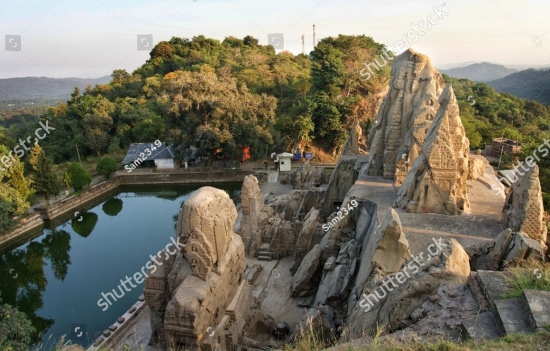 Temple overview. Tank is front. Back of temple is
greenery.
Temple overview. Tank is front. Back of temple is
greenery.
“The main temple at Masroor is strategically aligned to the sunrise of the first day of the solar year, indicating the advanced astronomical knowledge possessed by its builders.” Incredible
India
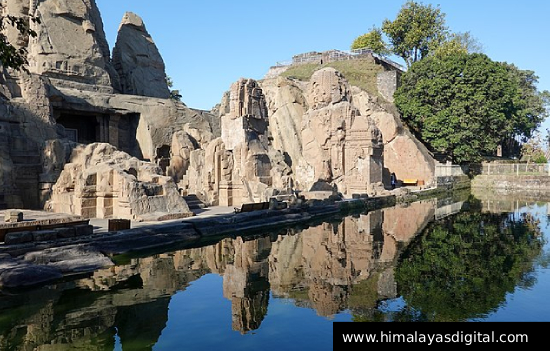 Side view with reflection in kund.
Side view with reflection in kund.
According
to local folklore the Pandavas were associated with the temple.
It
is at a height of 2,500 feet and offers a superb view of the Dhauladhar Range. The
environment is serene.
1.
History and Dating
Precise Dating:
While local traditions are rich, archaeological and art-historical consensus
places the construction firmly in the early 8th century CE, specifically
between 750 CE and 770 CE. This dating is based on stylistic analysis of the
iconography, architectural elements, and comparison with dated structures
elsewhere in India.
Architectural
Contemporaries: This period aligns with the flourishing of Nagara style in
other parts of North India. The intricate details and craftsmanship reflect the
peak of artistic expression during the Post-Gupta period in the region.
The
1905 Earthquake Impact: The devastating magnitude 7.8 Kangra earthquake of April 4,
1905, caused significant damage. While the core structure, being monolithic,
survived, some of the elaborate shikharas (spires) and delicate carvings on the
upper levels were lost or severely fractured.
Detailed reports from the
Archaeological Survey of India (ASI) at the time documented the extent of the
destruction. For instance, the main shikhara of the central temple was heavily
damaged, altering its original profile.
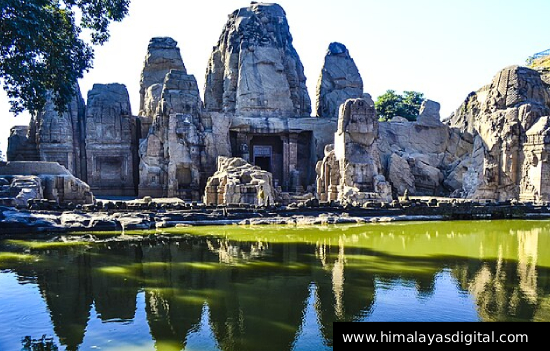
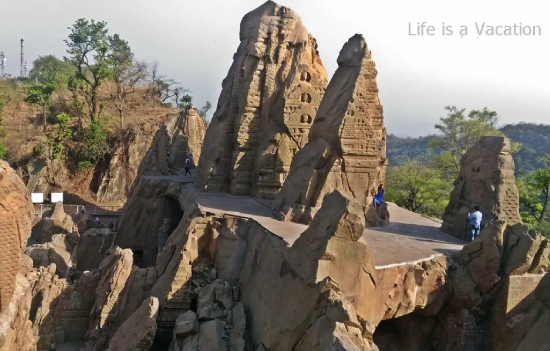 Top view. Note curvilinear shikharas.
Top view. Note curvilinear shikharas.
2.
Architectural Style and Features
Nagara
Style Prowess
Masrur is a rare example of
rock-cut Nagara architecture in North India. The typical Nagara characteristics
are evident -
Curvilinear
shikharas: Though damaged, the original curvilinear towers are
discernible.
Multi-storeyed arrangement:
The temples were designed with multiple levels, imitating structural temples.
Amalaka and Kalasha:
The crowning elements, amalaka (ribbed stone disc) and kalasha (pot-finial),
though fragmented, are consistent with the Nagara idiom.
Monolithic Grandeur and
Scale: The sheer scale of carving an entire complex, including the
main shrine (Thakurdwara), four subsidiary shrines, and surrounding elements, out
of a single rock face is astounding. This feat required meticulous planning
and execution over many years, may be decades. The main shrine itself would originally
have stood at app 30-40 feet.
Cruciform and Mandala Layout:
The temples are laid out in a cruciform (cross-shaped) configuration around the
central shrine, mirroring the principles of Vastu Shastra and the traditional
mandala designs found in Hindu temple architecture. This suggests a highly
organized and symbolic architectural program.
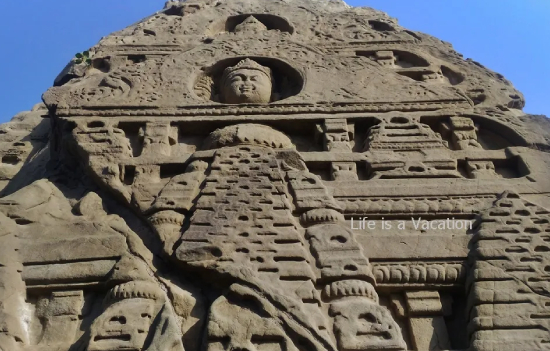 Close up of one of the shikhara.
Close up of one of the shikhara.
 Close up of one of the smaller shikharas.
Close up of one of the smaller shikharas.
According to the Kangra District
site, “The temples were carved out of monolithic rock with a shikhara, and provided with a sacred pool of water. The temple has three entrances on its northeast, southeast and northwest side, two of which are incomplete. Evidence suggests that a fourth entrance was planned and started but left mostly incomplete, something acknowledged by the early 20th-century colonial era archaeology teams but ignored leading to misidentification and erroneous reports. The entire complex is symmetrically laid out on a square grid, where the main temple is surrounded by smaller temples in a mandala pattern.”
Elaborate
Sculptural Program
The Masrur complex features
a rich iconographic program with over 100 individual sculptures or panels. We need a Museum to house old sculptures.
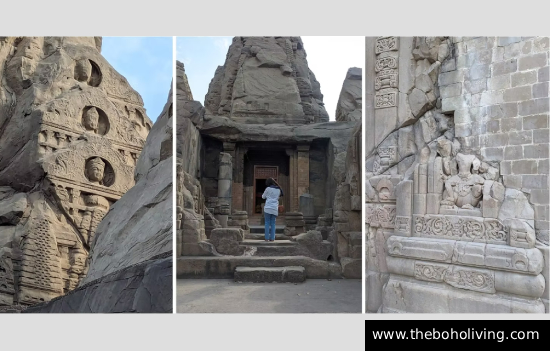 Collage of Temple entrance. It is a Shiv ji mandir though other deities are present.
Collage of Temple entrance. It is a Shiv ji mandir though other deities are present.
Trimurti and Major Deities:
The main deity in the central sanctum is identified as Sri Ram (Vishnu),
flanked by Lakshmana and Sita. However, the prominent relief of Shiva (as
Nataraja, the cosmic dancer) on the external wall near the entrance, along with
carvings of Ganesha and Kartikeya, confirms a strong Shaivite patronage.
Additionally, large
sculptures of Surya (the Sun God), Indra, and various forms of Devi (such as
Durga Mahishasuramardini) are present, indicating a comprehensive pantheon.
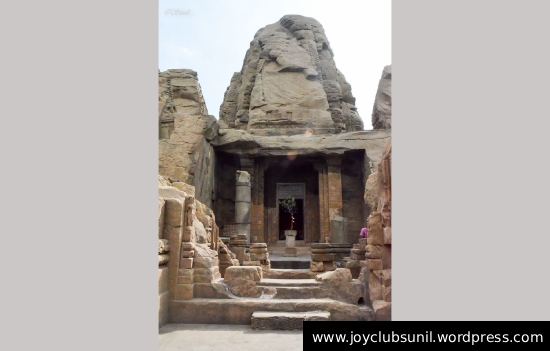 Entrance to main temple. Closer view.
Entrance to main temple. Closer view.
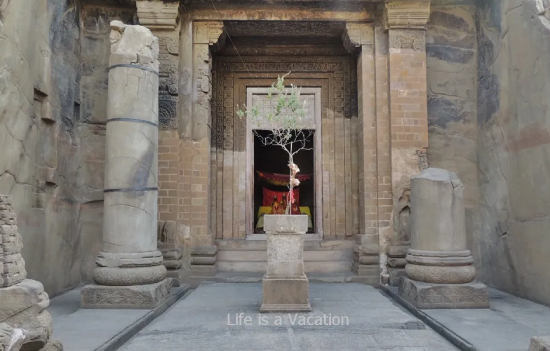 Note Tulsi in front and decorated panel.
Note Tulsi in front and decorated panel.
Fusion Deities:
The presence of Harihara (syncretic image of Vishnu and Shiva) and
Ardhanarishvara (half Shiva, half Parvati) is significant. (These are also
found at Five Rathas, Mahabalipuram and Temples of Aihole, Karnataka).
These composite forms
highlight the theological inclusivity and the attempt to reconcile different
sectarian traditions prevalent during that era.
Traditional Narratives:
Panels depict scenes from the Epics, Puranas, and Panchatantra fables, offering
insights into cultural and narrative context then.
Sacred Kund:
The rectangular sacred pond in front of the temples, measuring approximately 50
x 30 feet (15 x 9 meters), collects rainwater and serves as a ritual bathing
site. Its reflection of the temples creates a visually stunning effect,
especially at sunrise or sunset.
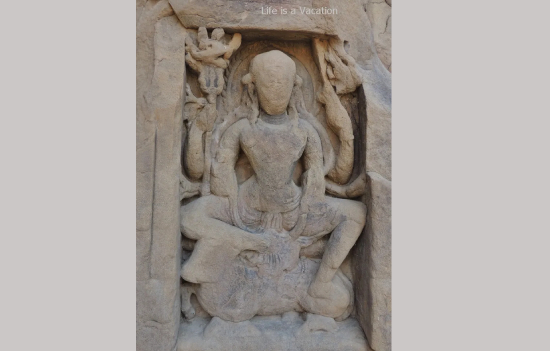 Shiv ji. Credit Sangeeta – lifeisavacation.in
Shiv ji. Credit Sangeeta – lifeisavacation.in
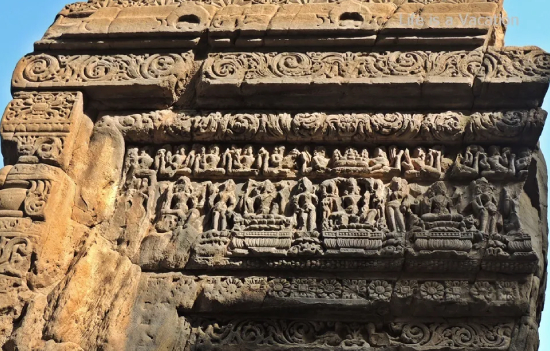 Carvings temple panel. Please help with more information. Credit Sangeeta – lifeisavacation.in
Carvings temple panel. Please help with more information. Credit Sangeeta – lifeisavacation.in
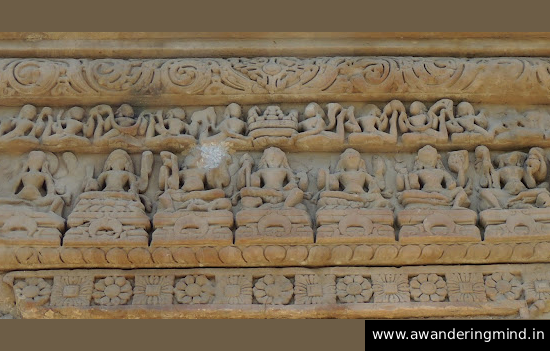 Saptamatrika.
Saptamatrika.
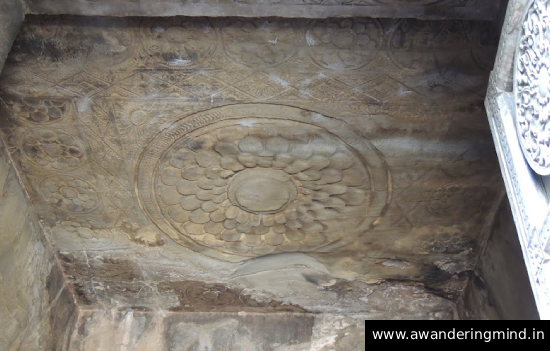 Ceiling of temple sanctum.
Ceiling of temple sanctum.
3.
Religious Significance
Active
Worship and Preservation: Despite being an
archaeological site, the central shrine of the Masrur Temples remains an active
place of worship.
The murtys of Sri Ram,
Lakshmana, and Sita are relatively modern additions, likely placed there in the
late 19th or early 20th century after the original primary deity (likely Shiva
or Vishnu) was lost or damaged. The Archaeological Survey of India (ASI) now
maintains the site.
Festivals
and Pilgrimage: The temples draw a significant number of devotees, particularly
during major festivals like Maha Shivratri (February/March), Ram Navami
(March/April), and Janmashtami (August/September). These occasions see a surge
in visitors, highlighting the enduring spiritual connection.
Historical
Evidence of Synehthesis: The diverse
iconography, with equal prominence given to Shiva, Vishnu, Surya, and Devi,
suggests a period of even synthesis in the Kangra Valley during the 8th
century. It indicates that the patron rulers (whose identity remains largely
unknown, possibly local Rajput chieftains) embraced multiple facets of the
Hindu pantheon.
4.
Unique Aspects & Similarities
"Ellora
of Himachal": This moniker is well-deserved due to the complex's monolithic nature and ambition, directly comparable to the scale and artistry of the Kailasa Temple
Ellora, Maharashtra, carved during the same general period by the
Rashtrakutas.
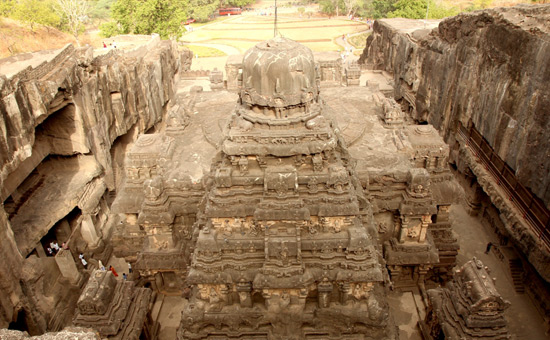 Kailasa Temple, Ellora.
Kailasa Temple, Ellora.
However, Masrur is unique for its Nagara style in rock-cut form, whereas Ellora's Kailasa is predominantly Dravidian.
Angkor Wat Connection (Speculative but Noted): Some scholars, like M.C. Sharma, have pointed out intriguing conceptual and design similarities between Masrur's cruciform layout and the famous Angkor Wat temple complex in Cambodia, particularly in the arrangement of subsidiary shrines around a central axis.
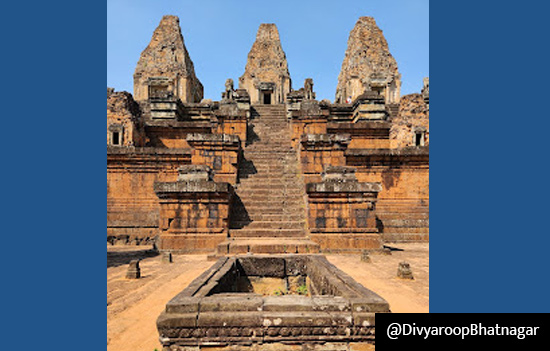 Angkor Wat.
Angkor Wat.
While direct historical
links are not definitively proven, it suggests a pan-Asian architectural
language or shared cosmological understanding. This observation, though
academic, adds another layer of global significance to Masrur.
Under
Known and Appreciated Gem
Despite its historical and
architectural significance, Masrur is less known globally than some other
Indian archaeological sites, making it a truly rewarding discovery for those
who visit.
The Masrur Rock-Cut Temples stand as a remarkable testament to the skill, faith, and artistic vision of their creators, offering a tangible link to India's glorious past, even in their weathered and earthquake-scarred state.
How to reach Kangra from Delhi
Flight from Delhi to
Dharamshala takes about an hour. Dharamshala to Kangra is only 17 kms. Bus from Delhi to Kangra
takes about 11 hours.
Train - Nearest
Station: Kangra Mandir Railway Station (narrow-gauge). Major Railway Station
Nearby: Pathankot Junction (broad-gauge). From
Delhi: Take a train to Pathankot (direct from New Delhi or Old Delhi
railway station). Popular trains: Dhauladhar Express, Shalimar Express. Then
board the Kangra Valley Toy Train to Kangra or hire a cab (2.5 hrs).
Kangra to Masrur Rock-Cut Temples is app 39 kms, takes an hour.
To read all
articles by author and To see all albums
on Himachal
To see only albums of Kangra
1. Kangra Valley and
2. Dharamshala
Travelogues Himachal and Masrur Temples
1. The Best of Spiti
Valley and Kinnaur in 15 days
2. Ten Off Beat
places in Himachal Pradesh
3. Himalayas Digital
on Masrur Temples
4. Good Masrur Temple
pics and Here
5. Nice piece by
Wandering Mind on Masrur
Author - Vikas Sharma-Jugadu Engineer: From Ideas to Impactful Solutions,
Amplified by Voice Jugadu Engineer was
born from a singular vision: to transform abstract engineering concepts into
tangible, real-world impact. What began as a humble idea has rapidly blossomed
into a trusted partner for start-ups
and NGOs seeking not just solutions, but genuinely impactful results.
Check his U Tube Channel.
Visit his website
Albums of Rock-Cut Temples in India
1. Kailasa Temple,
Ellora
2. 5 Rathas
Mahabalipuram, Tamil Nadu
3. Jain Rock-Cut,
Gwalior Fort – not temple, but rock-cut surely.
eSamskriti is grateful to
travellers/bloggers whose temple photos it has used to showcase Masrur Temples.
Credits given as well.